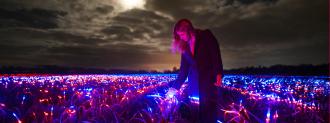Some artists paint portraits on canvas. Others chisel statues out of marble. Dutch artist Daan Roosegaarde’s medium of choice? A five-acre leek farm.
After two years of development, Roosegaarde has unveiled GROW, a new art installation in which multicolored LEDs dance across a huge field of leeks at night.
GROW is the first in a series of “dreamscapes” that the artist’s Studio Roosegaarde will create to demonstrate the beauty that can result from combining art and science in ways that better the world.
“I want to design things which make people curious about the future, not sad or mad,” Roosegaarde told Dezeen. “Light is my language. Light is not decoration; it’s activation and it’s communication.”
The artist was inspired to set this particular scene after learning that certain combinations of light have been shown to help plants grow and to protect them against disease and pests.
“A specific ultraviolet light activates the defense system of plants,” Roosegaarde said. “And what is interesting is that it works on all crops, so we can reduce the use of pesticides.”
Technologies harnessing these “light recipes” have been applied to the growing of plants indoors, in windowless warehouses and vertical farms.
Roosegaarde wanted to explore their potential use on a larger scale in rural, outdoor settings.
Living in the Netherlands, he didn’t have to go far to find the farm that would serve as the backdrop for his artwork — the tiny nation is the world’s second-largest producer of vegetables.
I want to design things which make people curious about the future, not sad or mad.
Daan Roosegaarde
The LEDs that Studio Roosegaarde set up are solar-powered and shine horizontally across the plants, giving the field a surreal, alien-like glow.
Due to the pandemic, GROW won’t be open to the public, but Roosegaarde hopes to take the installation on the road, using the LEDs to highlight local crops in 40 countries.
“People won’t change because of facts or numbers,” he wrote in 2019. “But if we can trigger the imagination of a new world, that’s the way to activate people.”
In the meantime, he plans to study whether briefly exposing the leeks to different wavelengths of ultraviolet light will reduce the need for pesticides on the farm.
We’d love to hear from you! If you have a comment about this article or if you have a tip for a future Freethink story, please email us at [email protected].






